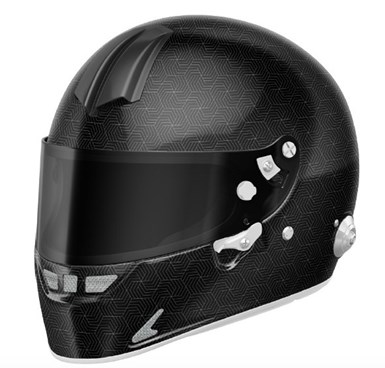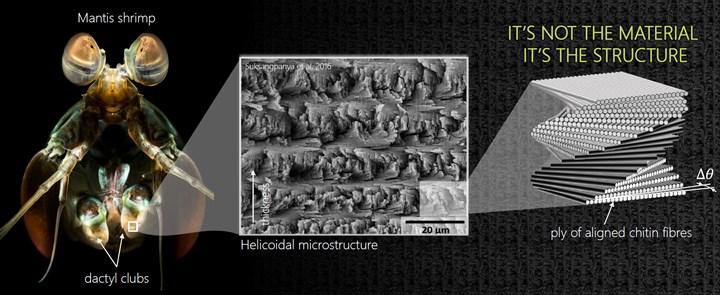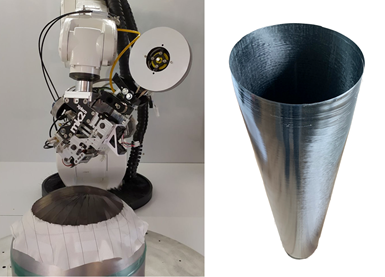
There are multiple ways to make composites using Helicoid Industries’ patented technology — including AFP, hand layup and filament winding — where the rotation of each ply in a composite laminate (top left) is tailored to achieve improvements in strength, damage-resistance, lightweight and durability. Photo Credit: Helicoid Industries
Helicoid Industries (Indio, Calif., U.S.) was established in 2019 to commercialize the Helicoid technology, patented by University of California Riverside (UCR) in 2016, with an exclusive license until 2034. Since its launch, the company’s IP portfolio has grown with additional pending patents, developing innovative features to exploit Helicoid technology with a wide range of raw materials, processes and applications — including carbon and glass fiber-reinforced polymers (CFRP, GFRP). The company claims this technology offers a range of performance improvements, weight and cost reductions. Examples include:
- Delay catastrophic failure by 74% (with thin-ply CFRP)
- Reduce localized dent depth by 50% (with aerospace-grade CFRP under low-velocity impact)
and improve:
- Impact strength by > 40% (measured for CFRP, GFRP and flax FRP)
- Residual compression strength after impact (CAI) by 20% and reduced notch sensitivity (OHT) with aerospace-grade CFRP
- In-plane and through-thickness damage diffusion by >100% (higher energy dissipation)
The claimed enhanced impact performance can be exploited to reduce structural weight and, in turn, reduce overall material use as well as the amount of higher-performance and costly (e.g., carbon fiber) materials required.
Helicoid Industries is working with 20 global leaders in sporting goods, protective gear, automotive, aerospace and wind applications, aiming for commercialization within 12-18 months while it finalizes a $5 million seed round of financing for future prototype manufacturing and additional biomimicry research initiatives.
What is a helicoid?
I wrote about helicoids and other hierarchical composites in my 2016 blog, “Bionic design: The future of lightweight structures”: Chitin as a building block is used at the angstrom, nanometer and micrometer levels of a lobster shell, but organized uniquely at each, to produce a hard yet resilient structure.
“Hierarchical and helicoidal microstructures are two of the most common features found in fibrous biomaterials,” says Dr. Lorenzo Mencattelli, director of R&D for Helicoid Industries. “Their constituent materials are organized differently at each level to provide uniquely lightweight yet damage tolerant structures. Contrary to conventional engineering, where structures are designed for strength, nature designs to maximize toughness. By architecting material constituents in highly heterogeneous structures, nature enables complex fracture patterns as a response, leading to fracture toughness that is orders of magnitude higher than that of the single constituents. This damage diffusion enables failure to grow in a controlled way, leading to unparalleled structural integrity.”
Mencattelli notes that helicoidal microstructures are frequently found in insect cuticles, wood and crustaceans. “For example, the dactyl clubs of the mantis shrimp are made from stacks of aligned chitin fibers embedded in a protein matrix, where each ply is rotated to form a helicoid. The result is a lightweight shell that can take hundreds of impacts without catastrophic failure.” He notes that this helicoidal structure has been researched for more than a decade at many different universities with results showing great potential. Adapting these for commercial applications, however, has been a problem.
“The challenge,” Mencattelli explains, “has been to understand the design drivers for embedding Helicoid structures in engineering applications, and to enable cost-effective manufacturability and scale-up. What we have developed at Helicoid Industries is an in-depth understanding of Helicoid architectures that enables us to design scalable, highly impact-resistant structures. We do this by tailoring the laminate to meet stiffness and strength requirements while maximizing impact protection. For example, we can design “directional” Helicoid laminates — which are not necessarily quasi-isotropic laminates (e.g., 0°/+45°/-45°/90°) — to offer in-plane directionality and yet improved impact protection. No new materials or manufacturing methods are needed to implement the technology and gain the performance benefits.”
History of Helicoid Industries
Helicoid Industries was founded by the company’s CEO, Chad Wasilenkoff. “My background is as an investor, who has grown more than 30 companies and taken more than a dozen public,” he explains. “I was volunteering at UCR in their business and entrepreneurial graduate classes, and asked, ‘you guys do hundreds of millions of dollars of research every year, what's the most interesting disruptive technology that you have that's ready to commercialize?’ They all immediately said it was this Helicoid technology.”
So, Wasilenkoff looked into it, hiring retired Boeing composites engineer Doug McCarville to do due diligence. McCarville determined the technology is revolutionary and is now Helicoid Industries’ CTO. “So, I started to expand our team and raise seed capital,” says Wasilenkoff. “Our goal is to raise $5 million, of which we’ve raised roughly $3 million so far. We’ve attracted world-class talent with team members in the U.K., France, Switzerland, Canada and a couple of locations on the U.S. East Coast.”
Impact resistance and besting fail-safe design
Mencattelli joined Helicoid Industries in 2021. “I was working at Imperial College (London, U.K.) in the department of aeronautics, looking at creative design strategies for improving the damage tolerance and damage resistance of high-performance composites by architecting their microstructures,” he says. “Biomimicry has been pivotal to my research. I also explored helicoidal design strategies to tackle the inherent brittleness of thin-ply composites. I decided that the patented Helicoid technology was really disruptive and that I wanted to contribute to develop and bring these bio-inspired high-performance composite materials to industry.”
During his Ph.D. research, Mencattelli showed how patented Helicoid composites design can improve impact damage resistance versus traditional quasi-isotropic laminates. “During testing, we measured various performance metrics, including peak load, energy dissipation and displacement at failure, and all of them showed a large, simultaneous increase as the fiber angle between consecutive plies in the structure is rotated and tailored,” he says.
The graphs at right show dissipated energy, delamination area and load- displacement curves for thin-ply CFRP Helicoid structures. “Photos of the damaged samples [at bottom right] show a big improvement in damage morphology from the conventional quasi-isotropic laminates, which have a very brittle type of fracture that localizes damage. In the patented Helicoid composites, the damage is much more diffused with lots of minor matrix cracks. Also, you can see how the tailored angle rotations allow for fiber reorientation that tends to wrap around the indenter and better resist perforation.”
Mencattelli describes other indentation tests (using an ASTM 7136 test fixture) of aerospace-grade CFRP laminates made using automated fiber placement (AFP) and 200 gram/square meter (gsm) towpreg in collaboration with Carbon Axis (Perigny, France): “In these tests, it was not possible to break through the Helicoid laminates, which showed exceptional structural integrity and residual strength compared to a reference conventional quasi-isotropic laminate, which showed highly localized failure and full perforation. Furthermore, the excellent structural integrity of the Helicoid laminates was preserved when decreasing the weight of the laminate by 17%. This illustrates the capability of the technology to offer significant weight reduction while maintaining safety margins in critical components without compromising performance.”
This ability, says Mencattelli, to activate highly dissipative failure mechanisms, extensive sub-critical damage diffusion and complex crack patterns results in structures that are designed for superior damage tolerance. “Instead of overdesigning to suppress damage, the damage becomes a tool to efficiently sustain extreme loading scenarios, providing the best compromise between lightweight, performance and structural integrity.”
Simply rotating the plies?
So, switching from a conventional composite laminate to a Helicoid composite is just a matter of rotating each ply by 10 degrees? “It depends on the part,” says Wasilenkoff. “Sometimes we have maybe eight layers and a 15-degree rotation. Other times, like a golf club, it'll be 60 to 100 layers, and it might have full rotations through 360 degrees multiple times. For a pressure vessel holding hydrogen, we can have one type of Helicoid at the inner layer, where you want very small microcracking because you’re trying to ensure the gas doesn't leak, and then another type on the outer layers, tailored for impact resistance. For an automobile structure, we would perhaps use an altogether different Helicoid designed to prevent more catastrophic failure in a crash event.”
“We have patented any and all Helicoids,” notes Wasilenkoff, “but they're not all the same, and that's where we use our know-how and technology toolbox to work with various component manufacturers to give them the best performance for their specific application.”
Thin-ply, bi-angle extrapolated?
“This is not the same concept as bi-angle thin-ply,” says Mencattelli. “The idea behind Helicoid composites is different.” He explains that Steven Tsai’s patented concept of thin-ply, bi-angle laminates is related to tailoring stiffness and strength properties and the suppression of microcracking by adopting thin-ply technology. “By creating thin-ply noncrimp fabric (NCF) building blocks with off-axis plies, it is possible to build layups with a higher degree of off-axis fiber dispersion. This helps to deliver better homogenized properties and to reduce the effect of asymmetry in the layup, making it easier to design a structure without being constrained to symmetric layups. The use of shallow angles can also be an advantage in specific loading conditions such as uniaxial compression.”

Micrographs of conventional quasi-isotropic versus Helicoid composite laminates. Photo Credit: Helicoid Industries
“Alternatively, our technology targets out-of-plane performance and does not rely on thin ply technologies,” says Mencattelli. “How many plies you need depends on the design space of the application. For an automotive part using only four unidirectional (UD) plies, you would need to increase the number of plies to allow for the Helicoid, and that would then require thinner plies. This might lead to a cost increase that can be recovered by decreasing the overall structural weight and using less raw materials. But we can use standard ply thickness if we have a higher ply count and a minimum of eight plies. The more plies we have available, the more we can optimize because we have a larger design space.”
Manufacturability
“There are multiple ways to make composites using patented Helicoid technology,” says Wasilenkoff, “including AFP and other commonly used manufacturing processes. In AFP, with a simple software change, it is possible to achieve any Helicoid layup sequence with minimum waste. For hand and automated layup, you can just change the angle and orientation of the fibers as the plies are being cut to shape and then position the plies by hand or via pick-and-place automated preforming to achieve the designed Helicoid layup sequence. There is virtually no change in the manufacturing steps compared to conventional laminates. This allows for quick deployment of our Helicoid technology to improve current designs.
He says Helicoid manufacturing is also possible with filament winding for shafts, tubes and pressure vessels. “We've created Helicoids using this method as well, so there's no change to manufacturing, materials or curing,” notes Wasilenkoff. “We’ve worked with glass, aramid and carbon fiber as well as various resins. We've had no problems with resin-infusion of Helicoid dry preforms or with preforming of prepreg tapes.”
Another challenge was shaping flat Helicoid layups into 3D preforms, he says, “but we've been able to solve that, delivering preforms with good drapeability. So, we’ve made preforms for helmets and curved parts and we're getting great results.” Mencattelli notes the company is also looking into thermoplastic composites.
What about 3D printing? “Helicoid is a great match for additive manufacturing technologies such as AFP and 3D printing. At Helicoid Industries, we have mostly focused on AFP, which is a mature technology in industry. With regards to 3D printing of continuous fiber-reinforced composites, Helicoid has been explored at a lab scale. Ongoing research includes work done at one of the University of California labs. We haven't worked to commercialize 3D printing yet, but the tests so far show the same performance benefits as seen with other Helicoid composites. Overall, by applying the technology at the structural level and not at the constituent level, we are able to use Helicoid with most manufacturing technologies”.
Applications
Mencattelli claims aerospace-grade Helicoid structures can achieve 17% weight reduction versus quasi-isotropic laminates, with up to 54% higher energy absorption, 27% shorter cycle time (using AFP) and at least an 11% reduction in raw materials (for hand layup processes). These results come from the work Helicoid Industries has completed with Carbon Axis and were presented in a technical paper at CAMX 2021.
“The superior perforation resistance of Helicoid composite laminates is a huge advantage for the next generation of engine containment casings and composite blades for aircraft propellers and jet engines,” he notes. “In the case of a blade-off event, you can stop that blade from perforating the containment ring and engine nacelle, preventing severe damage to the fuselage.” He points out this is a solution that can be integrated with already qualified materials and manufacturing processes, and thus easy to implement in the short-term to gain a quick market advantage.” Mencattelli concedes that the technology has a few limitations. “You do need a certain number of plies for it to work. We have struggled sometimes with sporting goods and other applications where there are only a few plies in the laminates, but for aerospace, in general, we have no real issues in implementing the helicoid technology.”
In automotive applications, more sustainable solutions are required to achieve a positive carbon footprint for high-volume part production. Conventional glass fiber composites have a 50% higher carbon footprint than natural fiber composites such as flax. Helicoid™ technology enables a larger use of bio-based fibers by enhancing the performance of natural fiber composites. “In automotive, bio-based composites for load-bearing structures are hindered by low performance/cost ratios. We have achieved a 52% improvement in impact strength for flax/epoxy laminates compared to conventional laminate designs” says Mencattelli. “This behavior is ideal if you want to protect components such as battery packs in electric vehicles. You are making more efficient use of your material, and in the case of a severe impact event, you are also able to stop and avoid perforation. You don't need additives to your resin, but instead can work with materials that are already commercially available and that is what we are doing. Our Helicoid technology is really driving the improvement in performance away from the constituents, and instead to the structural design.”
Helicoid composites tested for resistance to rain erosion in the leading edge of wind blades have shown at least a 34% reduction in eroded mass of the composite substrate (bottom image) compared to conventional laminates (top image). Photo Credit: Helicoid Industries
In wind energy, Helicoid composites are being tested for protection against rain erosion in the leading edge of wind blades. “In preliminary investigations, we are seeing at least a 34% reduction in eroded mass of the composite substrate, leading to more durable blades, which reduces maintenance downtime and increases electrical production,” says Mencattelli. “Tailored Helicoid laminates are currently in development for cost-effective implementation in wind blade applications through a collaboration with CaltestBed, University of California Irvine and leading NCF fabric suppliers.”
In high-performance sporting goods, thin-ply carbon fiber/epoxy Helicoid laminates have been shown to achieve a simultaneous 92% increase in maximum carried load and 164% increase in energy absorption.

Photo Credit: Helicoid Industries
In motorcycle helmets, local fiber weight reductions of up to 25% have been achieved. “Helicoid-based helmets have shown at least a 20% reduction in the maximum g-force transmitted to the head,” says Mencattelli, “with superior structural integrity and resistance to perforation. These highlights from the case studies we are developing show the wide range of applications that can benefit from Helicoid technology and also its disruptive potential.”
“In addition to OEMs and parts manufacturers, Helicoid Industries is working with key raw material suppliers to cost-efficiently embed helicoid technology into multiaxial fabrics — including UD materials and noncrimp fabrics (NCF) — as well as into lightweight woven fabrics in thermoset prepreg, thermoplastic organosheet, tape and dry form,” says Wasilenkoff. But doesn’t each Helicoid application require specific tailoring? “For certain applications, we have found that we can work within a certain range of Helicoid angles and still outperform conventional solutions,” explains Mencattelli. “If we have the option to tailor layer by layer, such as with AFP, then we can achieve superior optimization. But with high-volume and cost-sensitive applications, such as in automotive and wind energy, which use NCF in roll format, we need to compromise maximum gain in performance for lower cost. However, we can still reduce weight and overall material usage.”
The composites industry continues to innovate and seek ever higher performing materials, processes and designs, adds Mencattelli. “Helicoid technology, inspired by truly superior materials in nature, is part of this ever-growing movement to deliver a new generation of high-strength, damage-resistant, lightweight, more sustainable and durable composites.”
Related Content
MingYang reveals 18-MW offshore wind turbine model with 140-meter-long blades
The Chinese wind turbine manufacturer surpasses its 16-MW platform, optimizes wind farm construction costs for 1-GW wind farms.
Read MoreRecycling end-of-life composite parts: New methods, markets
From infrastructure solutions to consumer products, Polish recycler Anmet and Netherlands-based researchers are developing new methods for repurposing wind turbine blades and other composite parts.
Read MoreCollins Aerospace to lead COCOLIH2T project
Project for thermoplastic composite liquid hydrogen tanks aims for two demonstrators and TRL 4 by 2025.
Read MorePolar Technology develops innovative solutions for hydrogen storage
Conformable “Hydrogen in a Box” prototype for compressed gas storage has been tested to 350 and 700 bar, liquid hydrogen storage is being evaluated.
Read MoreRead Next
Developing bonded composite repair for ships, offshore units
Bureau Veritas and industry partners issue guidelines and pave the way for certification via StrengthBond Offshore project.
Read MorePlant tour: Daher Shap’in TechCenter and composites production plant, Saint-Aignan-de-Grandlieu, France
Co-located R&D and production advance OOA thermosets, thermoplastics, welding, recycling and digital technologies for faster processing and certification of lighter, more sustainable composites.
Read More“Structured air” TPS safeguards composite structures
Powered by an 85% air/15% pure polyimide aerogel, Blueshift’s novel material system protects structures during transient thermal events from -200°C to beyond 2400°C for rockets, battery boxes and more.
Read More
















.jpg;maxWidth=300;quality=90)












